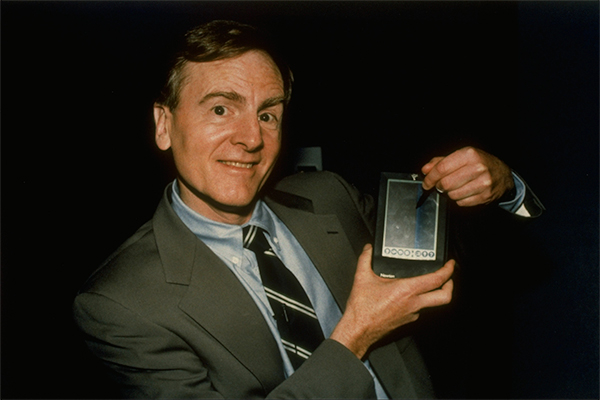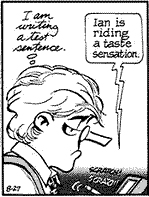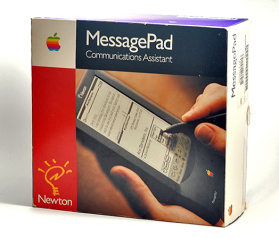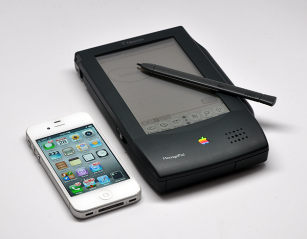In the grand scheme of things, 1992 is such recent history that it barely qualifies as history. When it comes to portable gadgets, however, it’s an era that’s nearly unrecognizable to us 21st-century humans.
Sure, there were pocketable gizmos back then: The Game Boy, for instance, had been around since 1989, and the Sony Watchman was hot stuff. There were even miniature computers, such as HP’s 95LX. But in 1992, nobody had an MP3 player. Or a GPS handheld. Or a smartphone. (Less than five percent of people in North America had a mobile phone, period.)
And in 1992, nobody had a PDA. That’s Personal Digital Assistant, in case you’ve forgotten, and even though nobody had one, lots of people were talking about them. Apple CEO John Sculley had coined the term in the keynote speech he made at the Consumer Electronics Show in Las Vegas on January 7. He announced that Apple would release PDAs–pocket-sized information devices, easier to use than a PC and selling for under $1000–in 1993.

Getty Images
Twenty years ago this week, on May 29, 1992, Sculley spoke again at another CES, in Chicago. This time, he didn’t just talk about PDAs. He brought one with him. It was a Newton, a prototype of the device which Apple planned to start selling in early 1993. Actually, Apple had multiple Newtons on hand that, which was good: The first one it unveiled on stage had dead batteries and didn’t work.
Using a second unit, Steve Capps, one of Newton’s creators, showed how you could use it to order a pizza by moving topping icons onto a pie and then sending out a fax. In 1992, that was show-stopping stuff.
The hype surrounding Sculley’s CES announcement of the Newton was immense, a precursor of the hoopla that would later accompany Steve Jobs‘ keynotes for iPods, iPhones, iPads and other post-Newton gadgets. But it didn’t change anything right away. Sculley, in fact, was demoing vaporware: The Newton was nowhere near ready. Apple held another unveiling fourteen months later at Macworld Expo in Boston, when the product which it officially called the MessagePad finally went on sale on August 2, 1993. (It was one of what was supposed to be a line of Apple products based on “Newton Intelligence,” most of which never came to be; Apple also licensed Newton technology to other companies.)

Universal Uclick
The earliest MessagePad reviews tended to accentuate the positive, but public sentiment quickly turned against Apple’s PDA, so much so that the Newton, like Microsoft Bob, remains convenient shorthand for “technology flop.” People remember that the handwriting recognition didn’t work–or, more specifically, that Garry Trudeau’s Doonesbury featured a week-long sequence in August of 1993 in which the handwriting recognition on Mike Doonesbury’s Newton-like PDA didn’t work. They recall that the Newton didn’t sell in huge numbers. They know that Steve Jobs axed it when he returned to Apple in 1997.
But simply dismissing Newton as a failure is unfair. Microsoft gave up on Bob after about a year; Apple, by contrast, stuck with Newton for six years. It released seven distinct models and worked with companies such as Sharp and Motorola, which released their own Newton-based gizmos. If someone other than Jobs had been in charge of Newton in 1998, the year it went away, it’s at least conceivable that there might be Newtons of some sort even now.
What Newton wasn’t was a hit. Apple sold 50,000 MessagePads in the device’s first three months on the market; the company trumpeted this figure as evidence that the gadget was selling briskly, but it was more likely a major disappointment. (In July 1992, MacWEEK‘s Jon Swartz reported that the company expected to sell a million Newtons in the first year.)
A lavish 1993 coffee-table book on the Newton project was titled Defying Gravity, but Newton’s problem was that it never quite took flight. In the six years between its premature debut and untimely death, it wobbled and sputtered like a leaky balloon, neither soaring nor crashing.
Of course, most of the people who have only a foggy understanding of why the first Newton failed to live up to the early irrational exuberance have a good excuse: They never actually used one. Including me.
I was a working technology journalist in 1992, but I paid only scant attention to the Newton’s launch. I didn’t try to get my hands on one when they went on sale in 1993, and didn’t bother to attend the unveiling at Macworld Expo Boston even though I worked nearby. In 1995, I bought my first PDA, Psion’s wondrous 3c; I don’t remember a Newton even being on my list of possibilities.
Several years later, I reviewed some of the final descendants of the original model, such as the MessagePad 2000, and met with the Apple executives who ran the Newton business. But when it dawned on me that 2012 marked the 20th anniversary of the Newton, I still felt like I wasn’t in a position to express informed opinions about it.
So I bought one.

Harry McCracken / TIME.com
Thanks to the modern miracle known as eBay, it’s not hard to acquire a Newton. I lucked upon a remarkable specimen: a first-generation model, the MessagePad H1000, running version 1.0 of Newton OS. It wasn’t just in mint condition, in the original boxes with all the original accouterments and documentation, plus a shrinkwrapped introductory videotape. There was no sign that it had ever been booted up. By buying such a virginal example, I would get the same Newton experience that the earliest adopters got when they plunked down their $699 in 1993.
eBay turned out to be an embarrassment of Newton riches. As long as I was shopping around, I bought a vintage external Newton fax/modem, capable of operating at a blistering 2400-bps. And a memory card called the Newton Enhancement Pack. And the Newton Connection Kit, which included hardware and software for hooking the MessagePad up to a Windows PC.
A few weeks later, my sister-in-law–who didn’t know of my Newton experiment–told me that she’d uncovered her own MessagePad H1000 and asked if I wanted to check it out. It turned out to be in nearly as pristine condition. I gratefully borrowed it as a backup.
This article isn’t a history of the Newton-here’s a good one–but rather my notes after six weeks as a Newton user, at long last. I had fun and wound up with a new appreciation for this groundbreaking gadget. But I also got a better sense of why it wasn’t the epoch-shifting breakthrough that Apple promised and pundits predicted.
Looming Large
Even before I used my new H1000 for the first time, I realized how unfamiliar I was with it. For one thing, I didn’t know it was so big. As the Wall Street Journal‘s Walt Mossberg pointed out in his 1993 review, it’s roughly the size of a VHS videotape. Technically, you can squeeze it in a coat or pants pocket–as long as you don’t mind everyone knowing that you have something roughly the size of a VHS tape stuffed in your pocket. A shirt pocket, however, is out of the question.
The MessagePad is an example of the gadget category which many people (including Steve Jobs) have disparaged as “tweeners.” Neither truly pocketable nor capable of replacing a full-blown PC, tweeners have never gone away. Current examples include Amazon’s Kindle Fire and Samsung’s Galaxy Tab 7.7.

Harry McCracken / TIME.com
That might help explain why so many people appeared to be oblivious to my MessagePad when I used it in meetings, on airplanes and at a fancy banquet: At first glance, a reasonable person might mistake it for a Kindle or a Nook, especially when its screen is shut off. At one point, I silently sat it on the table during a lunch I had with an employee of a legendary Silicon Valley company. (No, not Apple.) She didn’t exclaim “Hey, a Newton!” Instead, she gestured at it knowingly when we discussed the current tablet boom, as if it were an example.
Once I’d put four AAA batteries and a watch-battery backup into the MessagePad for the first time, powering it up felt like bringing it out of cryogenic suspension. Newtons, it turns out, begin their lives believing that it’s 5am on January 1, 1993. And the only way to set the year to 2012 is to flip the calendar forward, one month at a time. I tapped the MessagePad’s screen 230 times to set the date, watching the months flutter by like pages falling off a calendar to indicate the passage of time in some old movie.
As I did, I was already struck by a fact about the PDA’s screen: It’s terrible. Terrible.
This surprised me. Back in 1993, reviewers had plenty of beefs with the Newton, but display quality wasn’t one of them. Critics apparently thought the screen–monochrome, 240-by-336 pixels, no backlight–was okay. High-quality color LCDs already existed, but they were the stuff of $4000 laptops; nobody would have expected one on a $699 gizmo.
The H1000’s display is greenish gray on grayish green; there’s a contrast setting, but it only lets you choose between gradations that amount to bad, worse and illegible. In optimal light, with contrast set just right, the MessagePad’s screen is readable but unappealing. Anywhere else, it can be a challenge to make out. At a cocktail party in a murky bar– the sort of place where I generally peek at my iPhone a dozen times an hour–it was hopeless.
The screen doesn’t even look too impressive in the introductory video which came on a VHS tape with new MessagePads.
[youtube=http://www.youtube.com/watch?v=64QuJdJmCbA]
20/20 hindsight may make the MessagePad’s screen look worse than it seemed in 1993; its battery life, however, benefits from a couple of decades of diminished expectations. Back in the 1990s, people squawked that the MessagePad H1000 drained its four AAA batteries too quickly. I found, however, that I could go for a couple of weeks on a set. In an age of smartphones that conk out after less than one day, that was more than enough to keep me happy.


